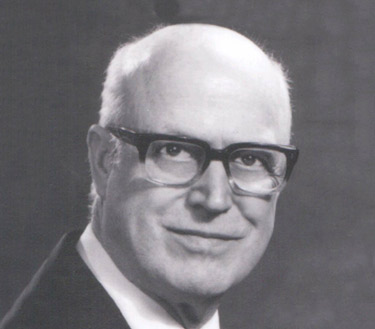Tupper, Earl S.

Earl S. Tupper
Tupperware Brands Corporation
Inducted 1976
Earl Silas Tupper (1907 – 1983) founded Tupperware Brands Corporation in 1938 as an inventor and entrepreneur. Through his creation and marketing of Tupperware, he furthered the growth of polyethylene after World War II and revolutionized the role of plastics in the American home. Tupper’s high-quality household items, which appealed to both economy and aesthetic delight, were instrumental in improving the image of plastics among consumers. At the same time, his partnership with Brownie Wise, who created the Tupperware Party concept of direct marketing, dramatically transformed American retailing.
Tupper was born to a modest New Hampshire farming family. He loved tending and fit in well with a long New England tradition of craftsmanship and inventiveness. He created labor-saving devices for the farm and family greenhouses; his first patent was for a frame to help clean chickens.
Tupper was an ambitious young man, determined to earn his first million by age thirty. In 1928, he took a course in tree surgery and set up his own tree surgery and landscaping business, Tupper Tree Doctors, whose success allowed him to continue to invent. In 1936, Tupper met Bernard Doyle, then head of the Viscoloid Corporation, the cellulosic plastics division of DuPont, where he soon went to work learning about plastics while working on his inventions and designs at night. 1938, he formed the Earl S. Tupper Company, mostly doing contract work for DuPont. During World War II, Tupper Plastics secured defense contracts, including molding parts for gas masks and Navy signal lamps. After the war, Tupper, like the rest of the plastics industry, diversified and developed new lines of plastics for the consumer market. At first, the company focused on creating products that other companies sold or offered as novelties or premiums: plastic sandwich picks, cigarette cases, and an unbreakable tumbler offered by Tek toothbrushes with the purchase of any toothbrush.
Tupper’s first major contribution to the industry was developing a method for purifying black polyethylene slag, a waste product produced in oil refinement, into a flexible, tough, non-porous, non-greasy, and translucent substance. This resulted in an affordable polyethylene (which Tupper named poly-T), which could be produced in a rainbow of colors and formed into a wide range of kitchen and home products. Tupper introduced the line in 1946 through department and hardware stores. Sales were steady but modest until the advent of Tupperware Home Parties (based on a similar strategy developed by Stanley Home Products). The Home Parties were an immediate success.
Tupper’s second important invention was the airtight and watertight Tupper seal. Because it was hard to market his new products, especially the “burp” seal, without demonstration, sales were slow until 1948 when Tupper met direct marketers Thomas Damigella and Brownie Wise. The three of them developed a new plan for Tupperware distribution: the Tupperware Home Party, a model that has been successfully adopted by everything from cookware to lingerie. Tupper developed the company rapidly, constantly introducing new products in the Tupperware line. In a decade, he had made his fortune, and in 1958, he sold the company to Justin Dart of Rexall Drug Company for $16 million. He subsequently renounced his United States citizenship and retired to Central America.
In February 1983, Earl Tupper gave a large collection of Tupperware—what he called a “time capsule”—to his friend Harold A. Holz. Holz subsequently donated the collection to the National Plastics Center and Museum in Leominster, Massachusetts, which later transferred it to the Plastics Collection at Syracuse University.

